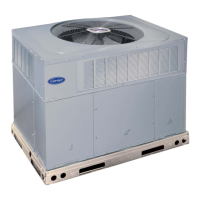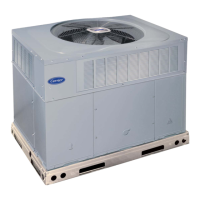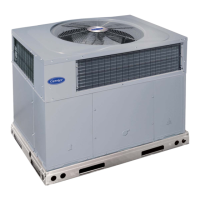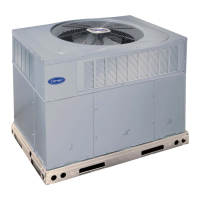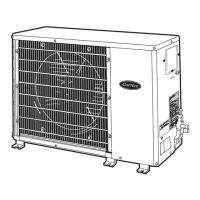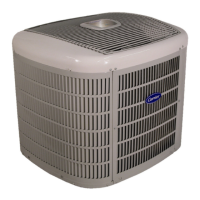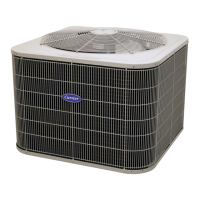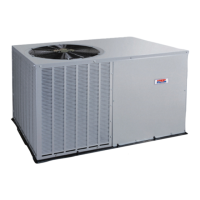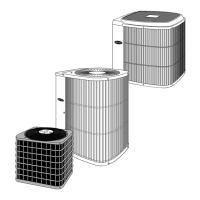50VR-K: Installation Instructions
Manufacturer reserves the right to change, at any time, specifications and designs without notice and without obligations.
13
outdoor temperature is below 40°F (4°C) (unless accessory low-ambient
kit is installed).
IMPORTANT: Three-phase, scroll compressors are direction oriented.
Unit must be checked to ensure proper compressor 3-phase power lead
orientation. If not corrected within 5 minutes, the internal protector will
shut off the compressor. The 3-phase power leads to the unit must be
reversed to correct rotation. When turning backwards, the difference
between compressor suction and discharge pressures may be near zero.
Checking and Adjusting Refrigerant Charge
The refrigerant system is fully charged with R-410A refrigerant and is
tested and factory sealed.
NOTE: Adjustment of the refrigerant charge is not required unless the
unit is suspected of not having the proper R-410A charge.
A subcooling charging chart is attached to the inside of the compressor
access panel. The chart includes the required liquid line temperature at
given discharge line pressures and outdoor ambient temperatures.
An accurate thermocouple- or thermistor-type thermometer, and a gauge
manifold are required when using the subcooling charging method for
evaluating the unit charge. Do not use mercury or small dial-type
thermometers because they are not adequate for this type of
measurement.
NOTE: Allow system to operate on high stage cooling for a minimum of
15 minutes before checking or adjusting refrigerant charge.
IMPORTANT: When evaluating the refrigerant charge, an indicated
adjustment to the specified factory charge must always be very minimal.
If a substantial adjustment is indicated, an abnormal condition exists
somewhere in the cooling system, such as insufficient airflow across
either coil or both coils.
1. Remove caps from low- and high-pressure service fittings.
2. Using hoses with valve core depressors, attach low- and
high-pressure gauge hoses to low- and high-pressure service
fittings, respectively.
3. Start unit and let run until system pressures stabilize.
4. Measure and record the following:
a. Outdoor ambient-air temperature (°F [°C] db).
b. Liquid line temperature (°F [°C]) at TXV.
c. Discharge (high-side) pressure (psig).
d. Suction (low-side) pressure (psig) (for reference only).
5. Using Cooling Charging Charts (See Fig. 20) compare outdoor-air
temperature (°F [°C] db) with the discharge line pressure (psig) to
determine desired system operating liquid line temperature (See
Fig. 20).
6. Compare actual liquid line temperature with desired liquid line
temperature. Using a tolerance of ±2°F (±1.1°C), add refrigerant if
actual temperature is more than 2°F (1.1°C) higher than proper
liquid line temperature, or remove refrigerant if actual temperature
is more than 2°F (1.1°C) lower than required liquid line
temperature.
NOTE: If the problem causing the inaccurate readings is a refrigerant
leak, refer to Check for Refrigerant Leaks section.
Indoor Airflow and Airflow Adjustments
NOTE: Be sure that all supply-air and return-air grilles are open, free
from obstructions, and adjusted properly.
This unit has independent fan speeds for low stage cooling and high
stage cooling. In addition, 208/230 VAC models have the
field-selectable capability to run enhanced dehumidification
(’DEHUM’) speeds on low stage and high stage cooling (as low as 320
CFM per ton). Coupled with the improved dehumidification associated
with low stage cooling, the DHUM speed allows for a complete
dehumidification solution independent of cooling stage. 208/230 VAC
models also have independent fan speeds for low stage gas heating and
high stage gas heating as well as a dedicated continuous fan speed. 460
VAC models offer a single gas heating speed and dedicated continuous
fan speed. Table 7 and Table 8 show the operation modes and the
associated fan speeds with each mode:
Table 3 shows the operation modes and the associated fan speeds with
each mode for all models:
The standard evaporator fan motor is factory set to provide 5 different
fan speeds to choose from for the various operation modes (see Table 4).
All models are factory-shipped for nominal high stage and low stage
cooling airflow operation at minimum external static pressure. See
Table 2.
WARNING
!
EXPLOSION HAZARD
Failure to follow this warning could result in
death, serious personal injury, and/or property
damage.
Never use air or gases containing oxygen for leak
testing or operating refrigerant compressors.
Pressurized mixtures of air or gases containing
oxygen can lead to an explosion.
WARNING
!
UNIT OPERATION HAZARD
Failure to follow this caution may result in unit damage.
For cooling operation, the recommended airflow is 350 to 450 cfm for
each 12,000 Btuh of rated cooling capacity. For heating operation, the
airflow must produce a temperature rise that falls within the range
stamped on the unit rating plate.
WARNING
!
ELECTRICAL SHOCK HAZARD
Failure to follow this warning could result in personal injury or death.
Disconnect electrical power to the unit and install lockout tag before
changing blower speed.
Table 3 – Operation Modes and Fan Speeds
208/230 VAC Models
Operation Mode
Fan Speed Tap
Connection
Low Stage Cooling/Heat Pump LOW
High Stage Cooling/Heat Pump HIGH
High Stage Enhanced
Dehumidification Cooling
DH
Continuous Fan LOW
460 VAC Models
Operation Mode
Fan Speed Tap
Connection
Low Stage Cooling/Heat Pump LOW
High Stage Cooling/Heat Pump HIGH
Continuous Fan LOW
WARNING
!
ELECTRICAL SHOCK HAZARD
Failure to follow this warning could result in personal injury or death.
Disconnect electrical power to the unit and install lockout tag before
changing blower speed.
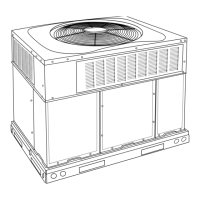
